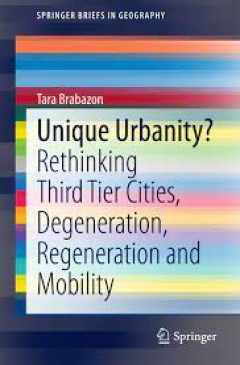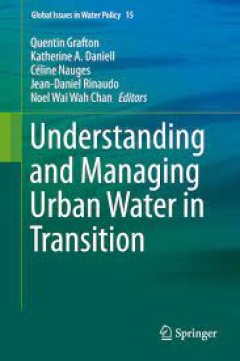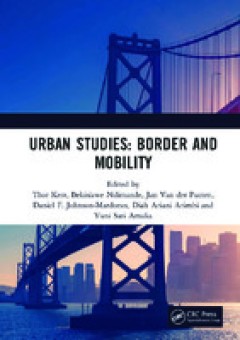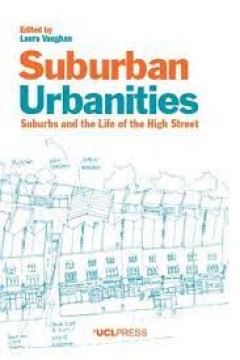Filter by

Unique Urbanity? Rethinking Third Tier Cities, Degeneration, Regeneration an…
This book investigates small cities - cities and towns that are not well known or internationally branded, but are facing structural economic and social issues after the Global Financial Crisis. They need to invent, develop and manage new reasons for their existence. The strengths and opportunities are often underplayed when compared to larger cities. These small cities do not have the profile …
- Edition
- -
- ISBN/ISSN
- 978-981-287-269-2
- Collation
- -
- Series Title
- -
- Call Number
- -

Engaging urban research in policy making: Towards equitable economic growth. …
Cities are considered “engines of economic growth,” yet many cities in the global South struggle to increase productivity and provide significant economic opportunities for their growing populations. There is a need to deepen the knowledge on the links between public goods and services and equitable economic growth and how to support such processes, in policy and strategic terms, locally an…
- Edition
- Ed. 1
- ISBN/ISSN
- 9783798332270, 9783798332270
- Collation
- 130
- Series Title
- -
- Call Number
- 338.9 ENG e

Destination London: The Expansion of the Visitor Economy
- Edition
- Ed. 1
- ISBN/ISSN
- -
- Collation
- -
- Series Title
- -
- Call Number
- -
- Edition
- Ed. 1
- ISBN/ISSN
- -
- Collation
- -
- Series Title
- -
- Call Number
- -

Understanding and Managing Urban Water in Transition
This book examines changes and transitions in the way water is managed in urban environments. This book originated from a joint French-Australian initiative on water and land management held in Montpellier, France. The book delivers practical insights into urban water management. It links scientific insights of researchers with the practical experiences of urban water practitioners to understan…
- Edition
- -
- ISBN/ISSN
- 978-94-017-9801-3
- Collation
- -
- Series Title
- -
- Call Number
- -

Urban Studies: Border and Mobility, Proceedings of the 4th International Conf…
This work contains a selection of papers from the International Conference on Urban Studies (ICUS 2017) and is a bi-annual periodical publication containing articles on urban cultural studies based on the international conference organized by the Faculty of Humanities at the Universitas Airlangga, Indonesia. This publication contains studies on issues that become phenomena in urban life, includ…
- Edition
- Ed. 1
- ISBN/ISSN
- 9780429507410, 9781138580343
- Collation
- 376
- Series Title
- -
- Call Number
- 711 URB u

Creative Industries and Urban Spatial Structure Agent-based Modelling of the …
This book explores the dynamics of the interaction between the development of creative industries and urban land use in Nanjing, a metropolis and a growth pole in the Yangtze River Delta. In the last two decades, China's economy has been undergoing dramatic growth. Yet, accompanying with China's economic success is the disturbing environmental deterioration and energy concerns. These issues tog…
- Edition
- 1
- ISBN/ISSN
- 9783319166100
- Collation
- XXII, 238
- Series Title
- Advances in Asian Human-Environmental Research
- Call Number
- 307.1216

Suburban Urbanities
Suburban space has traditionally been understood as a formless remnant of physical city expansion, without a dynamic or logic of its own. Suburban Urbanities challenges this view by defining the suburb as a temporally evolving feature of urban growth. Anchored in the architectural research discipline of space syntax, this book offers a comprehensive understanding of urban change, touching on th…
- Edition
- -
- ISBN/ISSN
- 9781910634158
- Collation
- -
- Series Title
- -
- Call Number
- -

Transitions to Sustainability
This book calls for the conditions of transition to sustainability: How to take into consideration new global phenomena such as and of the dimension of climate change, the depletion of natural resources, financial crises, demographic dynamics, global urbanization, migrations and mobility, while bearing in mind short-term or local place-based issues, such as social justice or quality of life? Me…
- Edition
- -
- ISBN/ISSN
- 978-94-017-9532-6
- Collation
- -
- Series Title
- -
- Call Number
- -

The Rise of the Common City On the culture of commoning
Artists and creative workers have long been attracted to urban environments. Yet the ‘creative city ‘of the 21st century comes with its own pitfalls. From precarity at the level of the worker to gentrification at the level of the city: the creative engine starts to sputter. Therefore, after or even against the creative city, this book highlights the ‘common city’. The Rise of the Common…
- Edition
- -
- ISBN/ISSN
- 9789461173492
- Collation
- -
- Series Title
- -
- Call Number
- -

European Planning History in the 20th Century A Continent of Urban Planning
The history of Europe in the 20th century is closely tied to the history of urban planning. Social and economic progress but also the brute treatment of people and nature throughout Europe were possible due to the use of urban planning and the other levels of spatial planning. Thereby, planning has constituted itself in Europe as an international subject. Since its emergence, through intense ex…
- Edition
- -
- ISBN/ISSN
- 9781003271666
- Collation
- -
- Series Title
- -
- Call Number
- -
 Computer Science, Information & General Works
Computer Science, Information & General Works  Philosophy & Psychology
Philosophy & Psychology  Religion
Religion  Social Sciences
Social Sciences  Language
Language  Pure Science
Pure Science  Applied Sciences
Applied Sciences  Art & Recreation
Art & Recreation  Literature
Literature  History & Geography
History & Geography